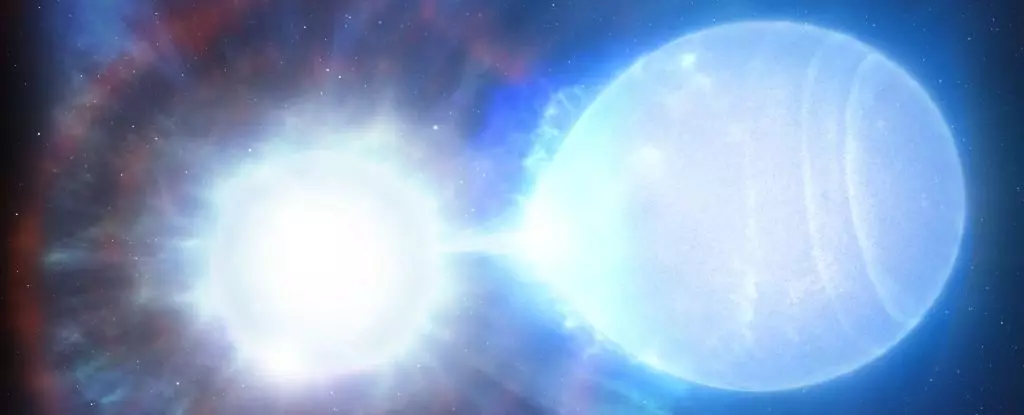In the grand tapestry of the universe, every star shines with a brilliance that belies its ephemeral nature. Each celestial body, whether a giant sun-like our own or a comparatively modest white dwarf, faces a common destiny: death. This demise marks not only the end of the star’s luminous life but also serves as a pivotal moment in the cosmic cycle of matter and energy. In the case of a fascinating binary star system, located a mere 150 light-years from Earth, scientists have pinpointed an exciting timeline for its spectacular conclusion—23 billion years hence. However, this system’s cosmic farewell will be hastened by an explosive Type Ia supernova, illuminating the night sky with a brilliance that will reverberate across the cosmos.
The Dual Fate of Binary White Dwarfs
White dwarf stars, often seen as the final resting place of stars like our Sun, are compressed remnants. Formed when stars exhaust their hydrogen fuel, they represent a transition from a life of active fusion to one where gravity reigns. Eventually, this leads to the formation of a white dwarf—a tightly packed mass, dense enough to house nearly 1.4 times the mass of our Sun within a sphere smaller than Earth. The study of the binary white dwarf duo known as WDJ181058.67+311940.94 has opened a window into understanding how these star pairs can trigger one of the universe’s most stunning displays.
The findings indicate that the two white dwarfs in the binary system are intimately connected, separated by only one-sixtieth of the distance between the Earth and the Sun. This proximity hints at an intriguing evolutionary path where the stars draw material from one another, eventually leading one to exceed the Chandrasekhar limit—the threshold beyond which a white dwarf can no longer maintain its structure.
A Groundbreaking Confirmation
Astrophysicists have long predicted that binary white dwarfs are key players in creating Type Ia supernovae, yet empirical evidence of this theory remained elusive until now. The peculiarity of this discovery lies not just in the tracing of supernovae back to white dwarf binaries but in the timing—it arrives impressively close to the universe’s own age of 13.8 billion years. James Munday from Warwick University articulates the significance well: this finding is not just a discovery; it is a landmark confirmation of longstanding theoretical frameworks.
The relationship between these white dwarfs composes a narrative of intense gravitational interaction and impending catastrophe that will unfold over eons, albeit with dire implications for the stars’ future. As they spiral toward each other, destined to unite in an explosive finale, they also provide a unique opportunity for scientists to trace the origins of Type Ia supernovae with newfound clarity.
The Importance of Type Ia Supernovae
Type Ia supernovae are not merely bright celestial events; they serve as fundamental tools in cosmology. During their brief yet powerful existence, they burst forth with a predictable luminosity, allowing astronomers to measure vast cosmic distances with unparalleled accuracy. This newfound confidence in connecting such supernovae to binary white dwarfs enhances our understanding of cosmic mechanics and element formation throughout the universe.
As these supernovae propagate through the cosmos, they disperse heavy elements such as carbon and iron—essential building blocks for new stars and planets. Thus, these explosive deaths contribute not only to the reckoning of individual star systems but also to the very fabric of the galaxy.
A Timeless Perspective
Approximately 23 billion years from now, when the dual stars of WDJ181058.67+311940.94 ultimately detonate, they will not pose a threat to our Earth or species. The end of this binary system, while inspiring dread, is part of a magnificent cosmic cycle. By the time this spectacular event takes place, humanity’s narrative may have already reached its conclusion. However, the implications of this finding are profound and illuminating for current astronomical inquiry.
The discovery not only highlights the dynamic interactions within a binary star system but also positions astronomers to seek out similar systems across the universe. As we explore our galactic neighborhood, the study of white dwarf binaries promises to unlock secrets that could reshape our understanding of stellar life cycles and the fate of matter in the cosmos. What remains unequivocal is that every star, as they burn brightly in the night, is a marker of time’s passage—each one contributing to the grand continuum of existence, slowly spiraling toward its spectacular end.

